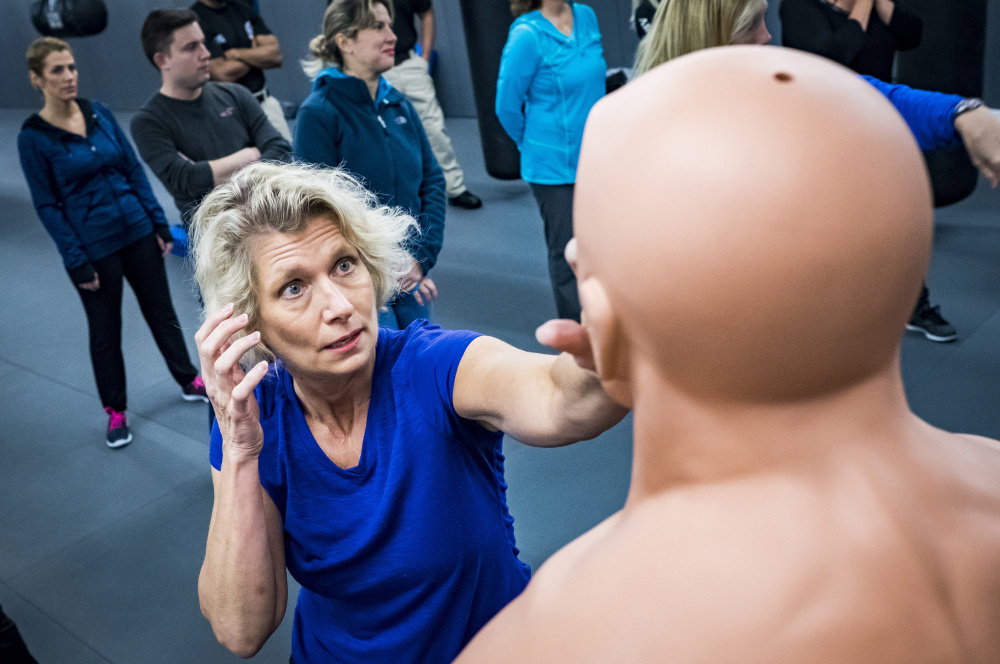As a flight attendant, Gina Hernlem has mastered many skills: maneuvering a beverage cart down a narrow aisle without dismembering a passenger, finding just enough space in an overhead bin to squeeze in that last carry-on, and easing the nerves of harried mothers flying with newborns.
Just this month, the diminutive 55-year-old added a new one: disarming a knife-wielding attacker with her bare hands.
Hernlem was one of more than a dozen veteran flight attendants who recently took part in a self-defense course designed exclusively for crew members at a federal facility near Dulles International Airport.
“I hope you never have to use it,” instructor Scott Armstrong told his class of mostly female flight attendants with decades of experience. “But there’s always that time.”
Armstrong retired as a master sergeant from Army Special Forces, then worked at the Secret Service’s training academy before joining the Federal Air Marshal Service in 2002.
“I’ve never been a fighter,” confessed Mark Gangler, a United Airlines flight attendant dressed casually in a T-shirt and workout pants. “But I think it’s important to know the principles of how to protect yourself.”
The four-hour class is offered without charge by the Transportation Security Administration at 20 sites around the United States. It’s voluntary, so participants must take it on their own time and pay their own travel expenses. Since its inception in 2004, more than 11,000 crew members have taken part.
Inside the training room, more than a dozen pairs of protective goggles were arranged carefully on a table. Next to them were several rubber daggers. A half-dozen large rubber dummies mounted on stands were positioned around the room, ready to be used for practice.
There was a bit of nervous laughter among the group as Armstrong began the lesson on close encounters. He emphasized three points: Move, block, strike. Using a dummy, he pointed to vulnerable spots above the shoulders: the ears, the throat, the nose, the eyes.
“You can rupture someone’s eardrums this way,” Armstrong said as he delivered a hard smack to Bob’s ear. “You don’t have to do both [ears]. Just one good slap on the side of the ear is going to cause some really good pain in that ear.”
The best way to avoid breaking a knuckle? Hit with the bottom of the palm instead of a fist.
Move, block, strike.
For flight attendants more accustomed to caring for passengers rather than cold-cocking them, the lessons required a shift in thinking.
“Don’t be nice with that arm,” Armstrong shouted as the group broke into pairs to practice dodging hits. “You want to put this person on the defensive, not the opposite.”
Like others in the class, Gangler never thought he’d need to know self-defense to do his job. But these days, he and others said, flights are more crowded, space on planes more confined and passengers sometimes more short-tempered and less patient. And even though more than a decade has passed since Sept. 11, terrorist attacks are always on their minds, they added.
Even so, Gangler said it took a push from Hernlem to persuade him and the others to set aside time to take the course.
Hernlem, who flies for United, recalled a recent flight on which a male passenger became belligerent, moving farther and farther into her space.
The man eventually backed down, but the incident stuck in her mind.
Internationally, reports of unruly airline passengers are on the rise. The International Air Transport Association said airlines reported a 14 percent increase in 2015, compared with 2014 figures.
Send questions/comments to the editors.



Success. Please wait for the page to reload. If the page does not reload within 5 seconds, please refresh the page.
Enter your email and password to access comments.
Hi, to comment on stories you must . This profile is in addition to your subscription and website login.
Already have a commenting profile? .
Invalid username/password.
Please check your email to confirm and complete your registration.
Only subscribers are eligible to post comments. Please subscribe or login first for digital access. Here’s why.
Use the form below to reset your password. When you've submitted your account email, we will send an email with a reset code.